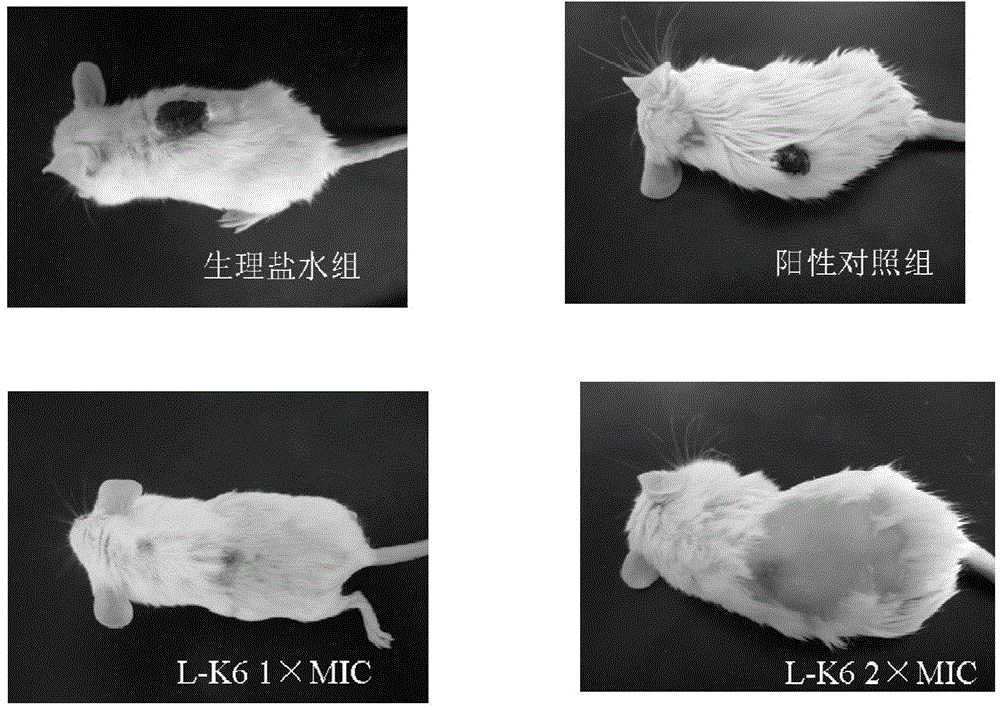New cationic antimicrobial peptide and application thereof
A cationic and antimicrobial peptide technology, applied in the direction of antibacterial drugs, peptides, antitumor drugs, etc., can solve the problems of low antibacterial and anticancer activity, limited popularization and application, and cytotoxicity of host cells, so as to promote skin wound healing , significant inhibitory effect, simple and convenient preparation method
- Summary
- Abstract
- Description
- Claims
- Application Information
AI Technical Summary
Problems solved by technology
Method used
Image
Examples
Embodiment 1
[0023] Preparation of antimicrobial peptides
[0024] 1. Chemical synthesis method of antimicrobial peptides: According to the amino acid sequence described in the summary of the invention, an automatic peptide synthesizer is used to synthesize according to the standard Fmoc solid-phase peptide synthesis procedure. Synthetic peptides were purified by reverse HPLC (Vydac218TP1022 column);
[0025] 2. The molecular weight was determined by matrix-assisted laser desorption ionization time-of-flight mass spectrometry (MALDI-TOF);
[0026] 3. The purity of the purified antimicrobial peptides is identified by high performance liquid chromatography (HPLC), and the purity used in the test is all greater than 95%. Determine the amino acid sequence structure with an automatic amino acid sequencer;
[0027] The antibacterial peptide of the present invention contains 13 amino acid residues in total, the molecular weight is 1552.13Da, and the isoelectric point is 10.70. The full amino a...
Embodiment 2
[0030] Antibacterial Experiment of Antimicrobial Peptides Against Gram-positive Bacteria
[0031] The pathogenic bacteria in the following examples all come from the General Microbiology Center (CGMCC) of the China Microbiological Culture Collection Management Committee and the China Industrial Microbiological Culture Collection Management Center (CICC), including: Staphylococcus aureus (AS 1.72), grapevine epidermis Coccus (CICC 23664), Bacillus cereus (AS 1.126), Enterococcus faecalis (CGMCC 1.595), Enterococcus faecium (CGMCC 1.2334), Streptococcus mutans (CGMCC 1.2500), Streptococcus salivarius (CGMCC 1.2498), Acidophilus Bacillus (CGMCC 1.3251), Streptococcus lactis (AS 1.1690).
[0032] Minimum inhibitory concentration (minimal inhibitory concentration, MIC): is the lowest sample concentration where no bacterial growth can be detected. The two-fold dilution method was used. The specific method is as follows:
[0033] Bacteria were inoculated on LB solid medium and cul...
Embodiment 3
[0039] Inhibitory Effect of Antimicrobial Peptides on Gram-negative Bacteria
[0040] The pathogenic bacteria in the following examples all come from the General Microbiology Center (CGMCC) of the China Microbiological Culture Collection Management Committee and the China Industrial Microbiology Culture Collection Management Center (CICC), including: Escherichia coli (AS 1.349), Pseudomonas aeruginosa Baumannii (CGMCC 1.860), Acinetobacter baumannii (CICC 22934), Fusobacterium nucleatum (CGMCC 1.2528), Klebsiella pneumoniae subspecies (CGMCC 1.716), Enterobacter cloacae (CGMCC 1.58), Proteus mirabilis ( CICC 22930).
[0041] The bacterial culture method and MIC determination method are consistent with the method described in Example 1.
[0042] The results are shown in Table 2. Antimicrobial peptides showed different degrees of antibacterial effects on Gram-negative bacteria, among which antibacterial effects on Escherichia coli, Pseudomonas aeruginosa, Acinetobacter baumanni...
PUM
| Property | Measurement | Unit |
|---|---|---|
| molecular weight | aaaaa | aaaaa |
Abstract
Description
Claims
Application Information
 Login to View More
Login to View More - R&D Engineer
- R&D Manager
- IP Professional
- Industry Leading Data Capabilities
- Powerful AI technology
- Patent DNA Extraction
Browse by: Latest US Patents, China's latest patents, Technical Efficacy Thesaurus, Application Domain, Technology Topic, Popular Technical Reports.
© 2024 PatSnap. All rights reserved.Legal|Privacy policy|Modern Slavery Act Transparency Statement|Sitemap|About US| Contact US: help@patsnap.com










